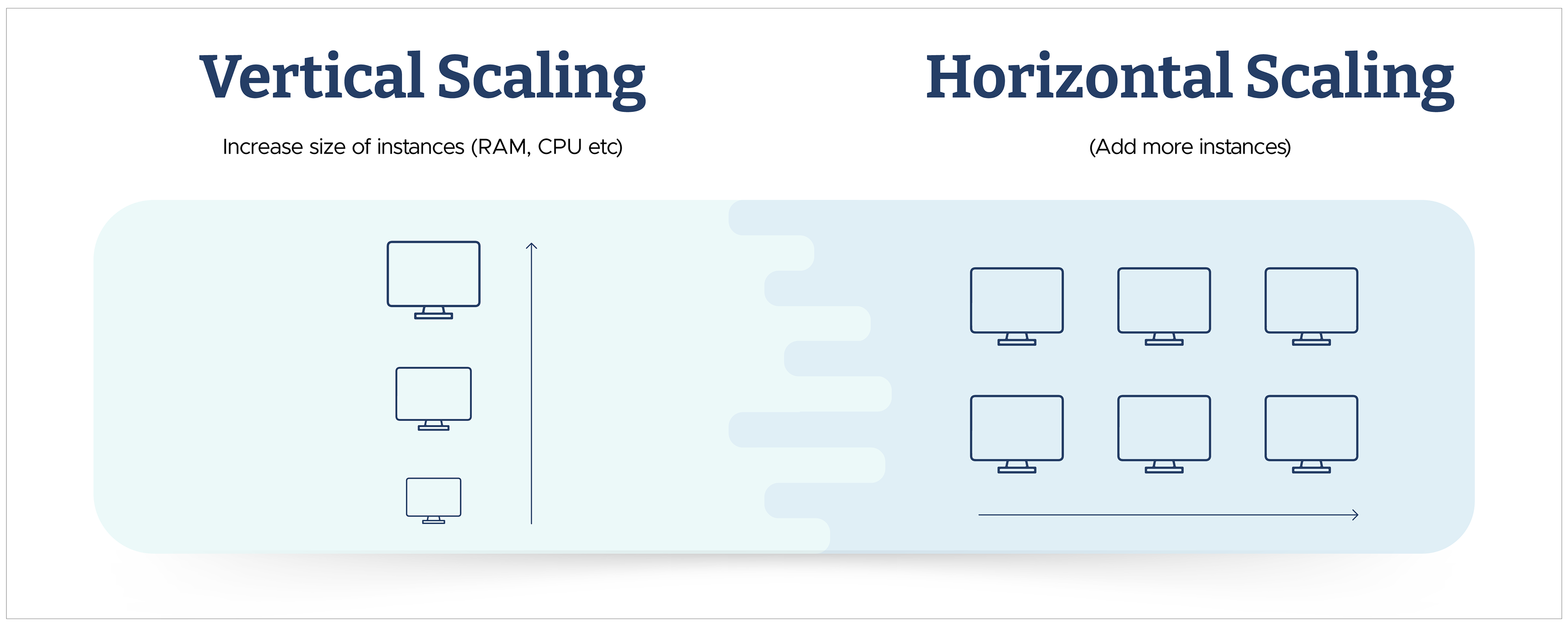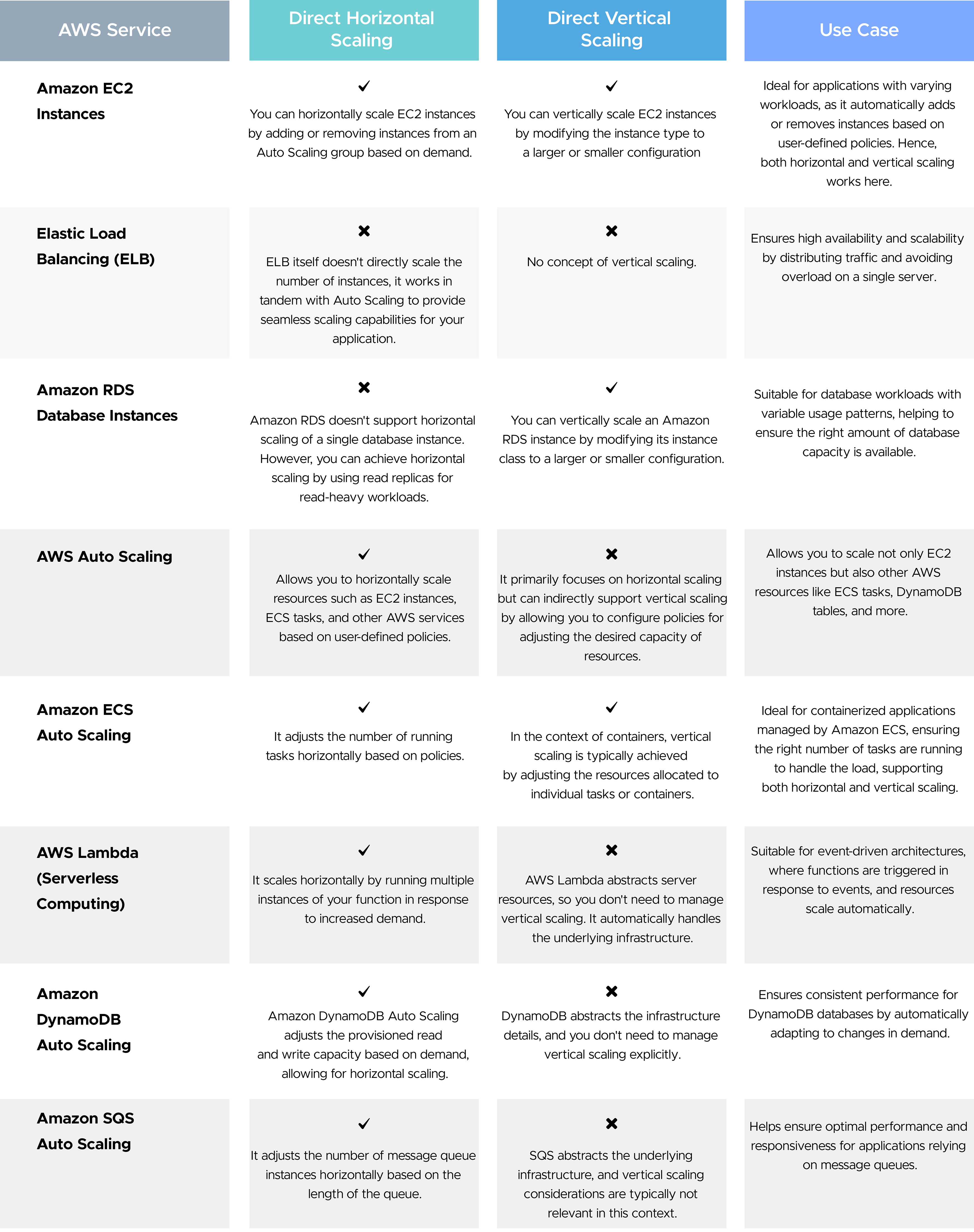Imagine you're hosting a party, and the number of guests can vary. Vertical scaling is like renting a bigger venue to accommodate more people. It involves increasing the capacity of the existing space, like moving to a larger hall with more capacity.
On the other hand, horizontal scaling is akin to hiring additional rooms in the same-sized venue. Instead of enlarging the existing space, you add more identical spaces to handle the increasing number of guests. Each room operates independently, contributing to the overall capacity and ensuring a smooth flow of the party.
In AWS terms, vertical scaling means increasing the size of a single server (more CPU, RAM, etc.), while horizontal scaling involves adding more servers to distribute the load across multiple machines. Let’s understand more about horizontal vs vertical scaling.
Scaling in AWS - Types and Differences
Scaling in AWS refers to the ability to dynamically adjust the resources of your application or system to accommodate changes in demand, ensuring optimal performance, cost efficiency, and reliability.
There are two primary types of scaling: horizontal and vertical scaling.
1. Vertical Scaling (Scaling Up)
Vertical scaling involves increasing the capacity of a single resource, such as upgrading a server's CPU, RAM, or storage.
AWS Example: You might vertically scale an Amazon EC2 instance by choosing a larger instance type with more compute power or memory.
2. Horizontal Scaling (Scaling Out)
Horizontal scaling involves adding more instances or resources to your application or system to distribute the load and handle increased demand.
AWS Example: You might horizontally scale a web application by adding more EC2 instances behind a load balancer, allowing the application to handle a higher number of concurrent users.

AWS Services and Resources - Scaled Horizontally, Vertically, or Both
Scaling extends across your cloud applications and infrastructure, encompassing EC2 instances, Elastic Load Balancer (ELB), Relational Database Service (RDS), Lambda functions, DynamoDB, and SQS (Sequence Queue Service).
The ability to scale resources, both horizontally and vertically, depends on the specific AWS service and resource in question. To answer the question of horizontal vs vertical scaling, consider the following breakdown of how each mentioned resource can be scaled:

In summary, many AWS resources can be horizontally scaled by adding or removing instances, while others, like EC2 instances and RDS databases, can also be vertically scaled by adjusting their configuration. The specific scalability options depend on the nature and design of each service.
Scaling Benefits in AWS
The ease for businesses to quickly add to its available pool of cloud resources, during high-demand usage, is what guides the success of the operation in hand. Horizontal and vertical scaling in AWS works towards striking the balance between seamless resource allocation and the performance of the system. Based on a particular use case, whether you choose horizontal scaling or vertical scaling, the following benefits can be enjoyed:
Performance Optimization
Imagine a single-lane highway struggling with traffic. Horizontal scaling in AWS is like adding lanes, allowing more traffic to flow smoothly and preventing delays. The power of horizontal scaling to deliver a consistently delightful experience can be seen during a sudden influx of online shoppers or a peak season for your SaaS platform.
Cloud Cost Efficiency
Think of paying for a gym membership you rarely use. Traditional infrastructure often leads to wasted resources and unnecessary costs. Scaling helps optimize resource usage.
By employing vertical scaling, you can upgrade the resources of existing instances instead of maintaining an unnecessarily large infrastructure. This translates to cloud cost optimization, akin to downsizing the infrastructure during slower periods. Furthermore, horizontal scaling empowers you to pay only for the instances you actively use, eliminating the burden of wasted resources and optimizing your cloud expenditure. So, horizontal and vertical scaling works in conjunction to bring cost efficiency.
Reliability and High Availability
Imagine a single bridge being the only way to cross a river: If it collapses, transportation grinds to a halt. Scaling helps build redundancy and resilience. With horizontal scaling, you create a safety net of redundant instances. If one instance encounters a technical error, like a stumbling acrobat, the others seamlessly pick up the slack, ensuring minimal downtime and uninterrupted performance. This distributed workload model enhances fault tolerance, safeguarding your application against unexpected challenges and guaranteeing high availability for your audience.
Elasticity
Think of a rubber band that can stretch and contract: Your AWS infrastructure should be able to adapt to changing demands. AWS Auto Scaling offers a similar level of flexibility. You define your scaling policies, like the magician's pre-planned tricks and <a data-cke-saved-href=" whitepaper="" www.cloudkeeper.com="">
Auto Scaling takes care of adjusting resources based on predefined metrics, be it CPU usage or network traffic. This ensures your application thrives amidst sudden market shifts or unexpected growth, allowing you to quickly add resources and scale up your performance in response to the market's applause.
Based on the details provided above, you can explore the benefits of horizontal and vertical scaling for your AWS resources and determine the most suitable option for your needs.
Whether you need to adapt to bursts of traffic or optimize costs, there's a scaling option for you. Horizontal scaling adds "rooms" (instances) to handle bigger crowds, while vertical scaling "upgrades" the existing space (resources).
Unsure about the best cloud strategy to adopt? CloudKeeper provides comprehensive Cloud FinOps Consulting and Support, helping you with all aspects necessary for your cloud to scale effectively.








